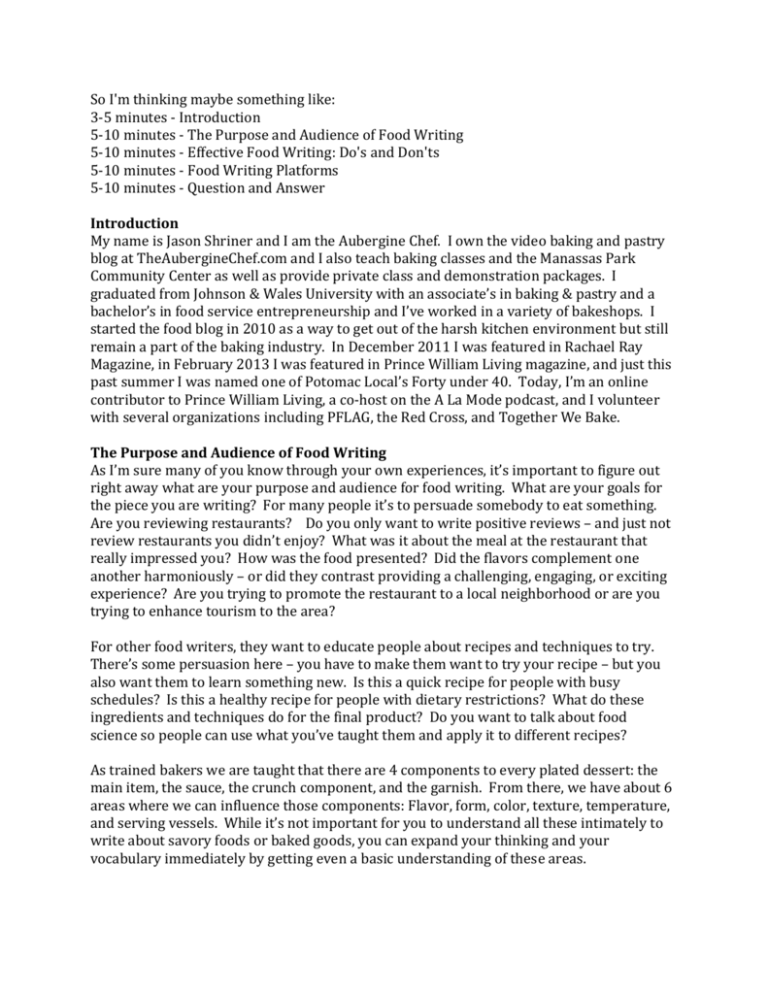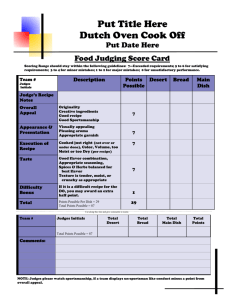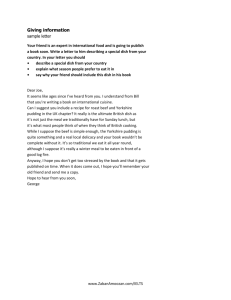Speaking Notes - The Aubergine Chef
advertisement

So I'm thinking maybe something like: 3-5 minutes - Introduction 5-10 minutes - The Purpose and Audience of Food Writing 5-10 minutes - Effective Food Writing: Do's and Don'ts 5-10 minutes - Food Writing Platforms 5-10 minutes - Question and Answer Introduction My name is Jason Shriner and I am the Aubergine Chef. I own the video baking and pastry blog at TheAubergineChef.com and I also teach baking classes and the Manassas Park Community Center as well as provide private class and demonstration packages. I graduated from Johnson & Wales University with an associate’s in baking & pastry and a bachelor’s in food service entrepreneurship and I’ve worked in a variety of bakeshops. I started the food blog in 2010 as a way to get out of the harsh kitchen environment but still remain a part of the baking industry. In December 2011 I was featured in Rachael Ray Magazine, in February 2013 I was featured in Prince William Living magazine, and just this past summer I was named one of Potomac Local’s Forty under 40. Today, I’m an online contributor to Prince William Living, a co-host on the A La Mode podcast, and I volunteer with several organizations including PFLAG, the Red Cross, and Together We Bake. The Purpose and Audience of Food Writing As I’m sure many of you know through your own experiences, it’s important to figure out right away what are your purpose and audience for food writing. What are your goals for the piece you are writing? For many people it’s to persuade somebody to eat something. Are you reviewing restaurants? Do you only want to write positive reviews – and just not review restaurants you didn’t enjoy? What was it about the meal at the restaurant that really impressed you? How was the food presented? Did the flavors complement one another harmoniously – or did they contrast providing a challenging, engaging, or exciting experience? Are you trying to promote the restaurant to a local neighborhood or are you trying to enhance tourism to the area? For other food writers, they want to educate people about recipes and techniques to try. There’s some persuasion here – you have to make them want to try your recipe – but you also want them to learn something new. Is this a quick recipe for people with busy schedules? Is this a healthy recipe for people with dietary restrictions? What do these ingredients and techniques do for the final product? Do you want to talk about food science so people can use what you’ve taught them and apply it to different recipes? As trained bakers we are taught that there are 4 components to every plated dessert: the main item, the sauce, the crunch component, and the garnish. From there, we have about 6 areas where we can influence those components: Flavor, form, color, texture, temperature, and serving vessels. While it’s not important for you to understand all these intimately to write about savory foods or baked goods, you can expand your thinking and your vocabulary immediately by getting even a basic understanding of these areas. When most people think of flavor they immediately think of the four basic tastes: sweet, salty, sour, and bitter – and many people are aware nowadays of the fifth basic taste umami or savory. These flavors are detected through taste buds and are some of the most immediate reactions you have to food. But flavor is more complicated than just those basic tastes – there’s aroma which is what gives you the grand variety of flavors you enjoy. Aroma is detected in your olfactory bulb in your nose which means it takes a little longer to detect aroma than flavor – and when you can’t breathe (like when you’re sick) you may not detect aroma at all. Aroma is what gives you the ability to distinguish between a real strawberry and artificial strawberry flavor. Speaking of artificial and natural think about where you stand on these areas as a writer. Do you appreciate the chef’s dedication to natural flavor’s wholesomeness or do you sympathize with chefs who use artificial flavors for their shelf-life, strength, consistency, and year-round availability? Does modernist cuisine where science, art, and flavor collide excite you? Do you relate more to soul food, the meals that are prepared with minimal processing and with thought and heart poured into every dish? Whereever you stand on this spectrum, it will greatly influence how you feel about food and will ultimately become your passion to the point where you want to persuade people to your side – even subconsciously. There’s no right or wrong side. Or maybe that’s your job to discover and prove. The remaining components allow a chef to be creative. With form you’re focused on the size and shape of the meal but also the height. When a chef is able to incorporate depth, it brings a level of enchantment and excitement to the dish. The category of color is surprisingly broad. Just as with flavor, how do you feel about natural colors vs. artificial colors? How many colors should be present in one cuisine? How about a monochromatic plate with varying shades? Do the colors complement or contrast each other and the dish? Do they enhance the experience even in a challenging way or do you find the colors over or underwhelming? Texture is very important to a particular dish. Have you ever heard, “I don’t like this food – it’s a texture-thing”? Texture also helps prevent a dish from becoming bland. Think of a bowl of soft custard – as you continue to eat it your mouth becomes bored bite after bite. It’s like the food version of diminishing returns. Now imagine the chef serves a crisp cookie with a slight flavor contrast. It awakens the mouth allowing you to enjoy the custard as if you started back at bite one. Temperature works the same way as texture – it provides a contrast allowing your mouth to reawaken bite after bite – and is arguably more difficult to implement. Finally, examine how the dish was presented to you. Is it trite or gimmicky? Does it enhance the dish? Does it reflect the environment where you are being served? Keep in mind that it is very difficult to stock a wide variety of dishes and glasses so try to think of serving vessels as going the extra mile to impress the diner rather than a definitive characteristic of the dish. Food writing goes beyond reviewing things that you’ve tasted. You could be designing a menu for a restaurant where being both precise and concise is valuable. As a blogger, I develop recipes and I have to cognizant of how I write my directions down. These are more technical examples of food writing, but describing food can also be more symbolic and meaningful. In novels – whether fiction or non-fiction – the way you incorporate food into your piece can have a powerful impact on the reader. Food connects us – all of us – and on some innate level we all understand food. If you intend to incorporate food writing into your work this way, think back on books you’ve read and analyze how the author utilized food and how it enhanced the piece. Ask if there are any other forms of food writing Activity 1 Taboo Style 1. Describe the item on the card without using the name or using any of the words on the card (spaghetti, margarita, devil’s food chocolate cake, mussels with wine sauce) 2. Describe the image on the card, other people have to draw it* Do’s and Don’ts of Food Writing Before we go through and discuss the list of words I found let’s review some brief do’s don’ts on food writing: Give a backstory – People love to hear a good story when they are talking about restaurants. How did the restaurant get started? What’s the restaurant’s overall message? Who is the chef? Where did they come from? If you’re contributing your own recipe be sure to include your story in relation to the dish. Use metaphors but don’t go overboard. Make them relevant to your voice. A little bit of humor can make a piece more enjoyable but a professional sounding piece will strengthen your credibility. I’m sure many of you have dealt with word limits especially if you contribute to publications. When you are cutting back on words make sure to read your piece aloud to your friends and family to make sure your voice and personality still shine through. Describe the food in question – don’t tell the reader how it tastes with subjective terms. Delicious, scrumptious, and delectable don’t tell you much about the food in question. Elaborate on the dish and allow the reader to draw their own conclusions. Don’t go overboard with too many details or adjectives. Consider writing the piece as a narrative that describes your entire experience. I like to think of this as the NPR style of food writing as nearly every time I listen to an NPR piece about food it tends to be very narrative. Think about using dialog in the piece to make it more engaging. Speaking of NPR, if you want to be inspired for your food writing listen to podcasts like NPR food, the Splendid Table, and The Sporkful with Dan Pashman. I absolutely love how they describe food and even though they may use words that are cliché or even completely made up I still feel engaged as a listener. They obviously have an advantage being in an audio format, but it can still motivate you as a writer. Play samples of audio Let’s go over some words that are popular in food writing. I’ve done some superficial research online and there are a ton of opinions on words not to use in food writing – but not much on words to use. While there are many words the different sources agree that should be banned from food writing, there is a lot of room up for debate. I don’t completely agree with this list, but I included many of those words anyway. If you find yourself using the same words on this list often, ban yourself from using those words. You guys are creative I know you can find a new way to describe the food. Review list with students and discuss and debate words Activity 3 Scattergories Style 1. Everybody gets a list of ten items and then has to describe the item using the letter drawn on a die. For every word that person gets a point but if another person has that word they don’t get a point – it must be a unique word. Food Writing Platforms For this final segment I want to focus on different food writing platforms and give you a chance to brainstorm ideas with each other on how to get into those areas. There are menus, blogs, publications, and prose for example. I think menus are some of the hardest things to write since space is a premium and often when you author a menu you also have to have a good sense of design – or at least be working with a good designer. Since being concise is valuable, word choice is that much more important. Avoid saying “flavored” as it makes everything it touches sound like junk food. I like to use inspired to describe menu items that I’ve taken liberties on (think “our twist on an old favorite”!). A menu should be quick to read to encourage turn over. However, if the establishment makes only a few items you can afford to be a little more wordy especially since the lack of menu variety may reduce the restaurant’s charm. Consider being bold and possibly wild to give the menu voice. Not everything has to read like an instruction manual. Have you ever heard of Thug Kitchen? It’s a food blog that tries to inspire people to eat healthy by using bold crass language – it may offend some people but it’s an excellent example of voice and branding. Blogging is one of the easiest ways to get started with food writing but it will take some time investment. There are some fees associated with blogging like webhosting but it’s usually not too financially inaccessible. However, as a blogger you need to have a more diverse set of skills. You’ll have to know how to design a website to appear professional which means you’ll need some coding skills – or at least know how to google how to code. Wordpress is an excellent platform as it makes everything visual and user friendly to assemble a website. (Wordpress.org vs. Wordpress.com) You’ll need photography skills since photos are what draw people into food blogs. You’ll need to manage your social media and test your recipes. Will you also do videos on youtube? Then you’ll need to know how to record and edit video. Blogs have almost no boundaries but that also means you’ll need a broader range of skills or you’ll have to hire people for those specific areas. However, if your blog is successful it can become your portfolio or your resume. Many people have turned blogging into a business with displaying advertising on their sites and working with brands to create sponsored posts. An example of a sponsored post is when a food blogger is given a brand’s ingredients (say King Arthur flour) and money to write about the ingredient. A sponsored post is supposed to be authentic and it should be an ingredient the blogger is truly interested in or is already using. Too many sponsored posts may damage a blogger’s reputation and authenticity but sponsored posts can also boost the blogger’s authority (a major brand wants to work with you) and even search rankings/visibility when the brand promotes the post. You can also write about food for publications like magazines and newspapers. I write for Prince William Living, a local magazine, and I contribute monthly food articles for their online version. The articles are similar to my blog posts but I try to be more brief and either educational or entertaining in the post depending on the recipe. I was able to get started writing with PWL through networking. For those of you unfamiliar with networking, basically you find business networking meetings that sound interesting to you and you connect with people there. Some of those people will become business acquaintances and some will even become your friends. Eventually your acquaintances and friends will invite you to additional meetings and to meet their connections and over time you’ll meet more and more people. When I started networking I didn’t have a specific goal – I just want to get into networking and meet as many people as I could. If you want to get in with a publication, you would find out which groups that publication gets involved with or who has connections at the publication and see if you can connect with them (LinkedIn is great for that). Writing novels is an area I’m pretty unfamiliar with but you can of course include food writing in your novel. Like Water for Chocolate is an excellent example. The book incorporates recipes and techniques at the beginning of chapters and uses food for powerful imagery. Here’s an excerpt: (page 50) Getting your novels launched is an area I’m unfamiliar with but there are and were a ton of great resources for that here at Fall for the Book. My personal friend Monica Bhide is an author and teaches food writing workshops as well. If I were thinking about launching a novel I would reach out to her first. Let’s end this workshop with questions and answers as well as a roundtable discussion. Words to use Herbaceous Peppery Bright Sparkle Community Connection Words to avoid Artisanal or Artisan Authentic (Is one dish more authentic than the other? Is there authentic fusion cuisine?) All Natural Organic Farm-to-table (locally sourced is better) Mouthfeel (I don’t mind it, but it may be too scientific for others to appreciate) Moist (I don’t mind it, but some people really hate it) Approachable (avoid when talking directly about food) Flavor/flavored Weak, over used, or cliché Cooked to Perfection (cliché) Fusion – describe the food directly, i.e. Asian-hipster cuisine Decadent Delectable Eatery Epic Luscious Nibbles, bites, victuals Pillowy (especially about pasta) Yummy Velvety or Silky Melt-in-your-mouth Savor Yummy Crispy (just use crisp) Devour Feel (use mood or atmosphere) Funky Gobble Iconic (just use famous) Mecca Mouth-watering Mound Nosh Ooze Slurp Sinful Scrumptious Trendy Uber To die for Noms Variety (be specific) Farm-raised (be specific) Gastropub (only if they refer to themselves as it) Locavore Foodie (try foodist, connoisseur, food enthusiast, food geek/nerd) Rustic With (your entire article could be something with something served with) Delicious Tasty Crowd-pleaser Lovely Fabulous Drool Dreamy Sources: http://blogs.phoenixnewtimes.com/bella/2014/06/food_drink_writing_words_avoid_not_ use.php http://grubstreet.com/2012/07/banned-food-writing-words.html http://urbanvegan.net/2011/08/101-overused-food-writing-terms.html http://www.au.timeout.com/sydney/restaurants/features/11079/25-words-to-avoid-infood-writing http://eatyourwordssmc.wordpress.com/course-info/hot-tips-for-food-writers/ http://www.theauberginechef.com/2013/08/4-tips-menu-writing/ http://www.theauberginechef.com/techniques-plated-desserts/ http://www.savorysimple.net/baked-eggs-and-chorizo/ http://www.fifteenspatulas.com/quick-ramen-noodle-soup/ http://www.abrowntable.com/home/rowntable.com/2013/08/easy-south-indianchicken-curry.html http://girlinthelittleredkitchen.com/2014/06/spiked-peach-mint-ice-tea/ http://www.theauberginechef.com/2013/11/episode-139-white-chocolate-moussecranberry-compote-gingersnap-cookies/ Activity 2 Charades Style 1. Close your eyes (so you’re not influenced by gestures) and describe your favorite food but never use the name of the item 2. Draw a category from a hat and describe your favorite item from that category (cocktails, dessert, bread, pie, sandwich etc) but never use the category name or the name of the item*



